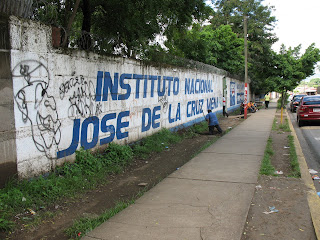I was in the Peace Corps office in Managua looking for teaching materials when I came across an op-ed in an English teaching magazine that was talking about how teachers reading the magazine should feel lucky to have classes with a maximum of 30 students, textbooks, and photocopies because even though it’s tough to imagine, some English teachers around the world don’t have those luxuries. You might not consider these basic things luxuries and five months ago we wouldn’t have either, but to English teachers in Nicaragua they definitely are.
In my school there is only one textbook and it is—no exaggeration—35 years old. It is really weird and so it teaches antiquated stuff like, “How do you do?” I had to explain to my counterpart that I’d never heard anyone use that phrase outside of an ESL textbook or a Hemingway novel, but it’s what everyone learns here. One textbook Holly used during training had a unit on eating out at a restaurant, and examples included “Have you tried our pea soup appetizer?” and “Do we have to check our coats?” These examples would be irrelevant for students in the US, but are even more unhelpful here where no one needs a coat, let alone a place to check it. Some of the textbooks are slightly more up-to-date… one book we’ve seen has a unit called, “Don’t buy that! It’s pirated!” and begins with a dialogue with a boy and a girl. The girl says, “Look at these Nike sneakers. And those Calvin Klein jeans! They’re so cheap!” and the boy looks at her gravely and says with his best Hermione Granger voice, “They’re not Calvin Klein or Nike. Don’t buy these things… they’re pirated.” That topic is certainly more trendy, but still not the most useful phrase in a place where pirated movies and fake Puma t-shirts rule the land.
When I say that there’s only one textbook I don’t mean that there’s only one option. I mean that there’s literally one book for the whole school. The teachers are the only ones with books, so any activity that comes out of the books has to be photocopied for the whole class. But schools don’t have photocopiers and so everything would have to be copied at a bookstore and paid for by the teacher. In the past, the schools would charge the students for the copies, but with the change in government the decision was made that education should be free with no strings attached, and now that practice is prohibido. Photocopies are about the same price here as they are in the US, but since teachers earn far less here and have nearly three times as many students in every section as a classroom in the States, copies are far too expensive for teachers to provide out-of-pocket for their students very often, if at all. What happens now is that any activity or exercise that we want to do in class has to be written on the markerboard, copied down by the students (which takes about 10 times longer than you’d think), and then the students can start learning. Difficulties with limited resources aren’t just limited to English class.
Unlike high schools in the US, here students are stationary and the teachers move around. Many of the classes at Holly’s school have at least 60 students, some with even more with most classrooms being no larger than a typical room in the States. Moreover, there are usually only about 50 desks in each class so there are a lot of students sharing; I don’t think students could keep from cheating if they wanted to. One time at school my counterpart and I did an activity where the students were supposed to describe members of their own families using adjectives that they learned in class. The next day they were writing some of their homework on the board and at least three students wrote the same wrong answer: “My brother is smal, fat, and handsome.” One clever student tried some to show that he wasn’t cheating by simply changing the sentence to “My sister is smal, fat, and handsome.” Sometimes I feel that the creed “eyes on your own paper” should probably be replaced by the more realistic plea, “please limit yourself to eyeing only the papers of your immediate neighbors.” Obviously, these combined challenges make it difficult for teachers to teach and students to learn; fortunately, however, we’re working with teachers here that believe that things can change to get kids interested in class and help them to learn English. Our Peace Corps project focuses on helping the teachers with their English, but perhaps more importantly (our boss would eagerly tell you) with using communicative, dynamic methods and developing locally available resources as simple as pictures from magazines or newspapers. The Peace Corps mantra is unarguably “sustainability,” so the idea is to not only teach kids English, but also to work with our counterparts to come up with ideas for the classroom that they can continue to use and share long after we’re gone.
Neither of us is under the impression that things will dramatically change immediately or even within the two years, so we’re trying to keep realistic expectations. We hope to be able to teach students that if they are going to cheat, they need to do it in a way that isn’t immediately obvious and when they come stroll into the pirated movie store in their $2 Puma shirt they can chide someone else in perfect English for wearing fake Nikes.
Here's the outside of my school:

This is the "inside":
Two students hanging out by the basketball court:
A first-year (7th grade) classroom:
The outside of Holly's school:
A picture of the concession stands:
Read more...























